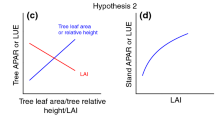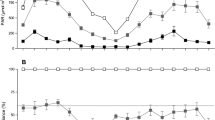Abstract
Game theoretical models predict that plant competition for light leads to reduced productivity of vegetation stands through selection for traits that maximize carbon gains of individuals. Using empirical results from a 5-year competition experiment with 10 genotypes of the clonal plant Potentilla reptans, we tested this prediction by analyzing the effects of the existing leaf area values on the carbon gain of the different genotypes and the consequent whole canopy carbon gain. We focused on specific leaf area (SLA) due to its role in the trade-off between light capture area and photosynthetic capacity per unit area. By combining a canopy model based on measured leaf area and light profiles with a game theoretical approach, we analyzed how changes in the SLA affected genotypic and whole-stand carbon gain. This showed that all genotypes contributed to reduced stand productivity. The dominant genotype maximized its share of total carbon gain, resulting in lower than maximal absolute gain. Other genotypes did not maximize their share. Hypothetical mutants of the dominant genotype were not able to achieve a higher carbon gain. Conversely, in other genotypes, some mutations did result in increased carbon gain. Hence, genotypic differences in the ability to maximize performance may determine genotype frequency. It shows how genotypic selection may result in lower carbon gains of the whole vegetation, and of the individual genotypes it consists of, through similar mechanisms as those that lead to the tragedy of the commons.



Similar content being viewed by others
References
Anten NPR (2002) Evolutionarily stable leaf area production in plant populations. J Theor Biol 217:15–32
Anten NPR (2005) Optimal photosynthetic characteristics of individual plants in vegetation stands and implications for species coexistence. Ann Bot 95:495–506
Anten NPR, During HJ (2011) Is analysing the nitrogen use at the plant canopy level a matter of choosing the right optimization criterion? Oecologia 167:293–303
Anten NPR, Hirose T (2001) Limitations on photosynthesis of competing individuals in stands and the consequences for canopy structure. Oecologia 129:186–196
Anten NPR, Schieving F, Medina E, Werger MJA, Schuffelen P (1995) Optimal leaf area indices in C3 and C4 mono- and dicotyledonous species at low and high nitrogen availability. Physiol Plantarum 95:541–550
Black JN (1964) An analysis of the potential production of swards of subterranean clover (Trifolium subterraneum L.) at Adelaide, South Australia. J Appl Ecol 1:3–18
Boonman A, Anten NPR, Dueck TA, Jordi WJRM, Werf AK, Voesenek LACJ, Pons TL (2006) Functional significance of shade-induced leaf senescence in dense canopies: an experimental test using transgenic tobacco. Am Nat 168:597–607
Callaway RM, Pennings SC, Richards CL (2003) Phenotypic selection and interactions among plants. Ecology 84:1115–1128
Chazdon RL (1992) Photosynthetic plasticity of two rain forest shrub across natural gap transects. Oecologia 92:586–595
de Kroon H, Schieving F (1991) Resource allocation patterns as a function of clonal morphology: a general model applied to a foraging clonal plant. J Ecol 79:519–530
de Kroon H, Huber H, Stuefer JF, Van Groenendael JM (2005) A modular concept of phenotypic plasticity in plants. New Phytol 166:73–82
de Kroon H, Visser EJW, Huber H, Mommer L, Hutchings MJ (2009) A modular concept of plant foraging behaviour: the interplay between local responses and systemic control. Plant Cell Environ 32:704–712
Dewar RC, Franklin O, Mäkelä A, McMurtrie RE, Valentine HT (2009) Optimal function explains forest responses to global change. Bioscience 59:127–139
Donald CM (1968) The breeding of crop ideotypes. Euphytica 17:385–403
Donohue K (2003) Setting the stage: phenotypic plasticity as habitat selection. Int J Plant Sci 164:S79–S92
Falik O, de Kroon H, Novoplansky A (2006) Physiologically-mediated self/non-self root discrimination in Trifolium repens has mixed effects on plant performance. Plant Signal Behav 1:116–121
Falster DS, Westoby M (2003) Plant height and evolutionary games. Trends Ecol Evol 18:337–343
Field C, Mooney HA (1986) The photosynthesis–nitrogen relationship in wild plants. In: Givinish TJ (ed) On the economy of form and function. Cambridge University Press, Cambridge, pp 25–55
Flintham JE, Börner A, Worland AJ, Gale MD (1997) Optimizing wheat grain yield: effects of rht (gibberellin-insensitive) dwarfing genes. J Agric Sci 128:11–25
Franklin O (2007) Optimal nitrogen allocation controls tree responses to elevated CO2. New Phytol 174:811–822
Gersani M, Brown JS, O’Brien EE, Maina GM, Abramsky Z (2001) Tragedy of the commons as a result of root competition. J Ecol 89:660–669
Givnish TJ (1982) On the adaptive significance of leaf height in forest herbs. Am Nat 120:353–381
Gruntman M, Novoplansky A (2004) Physiologically mediated self/non-self discrimination in roots. Proc Natl Acad Sci USA 101:3863–3867
Gutschick VP, Wiegel FW (1988) Optimizing the canopy photosynthetic rate by patterns of investment in specific leaf mass. Am Nat 132:67–86
Hamblin J, Donald CM (1974) The relationships between plant form, competitive ability and grain yield in a barley cross. Euphytica 23:535–542
Hardin G (1968) The tragedy of the commons. The population problem has no technical solution; it requires a fundamental extension in morality. Science 162:1243–1248
Hikosaka K, Anten NPR (2012) An evolutionary game of leaf turnover and its consequences for canopy structure. Funct Ecol. doi:10.1111/j.1365-2435.2012.02042.x
Hikosaka K, Hirose T (1997) Leaf angle as a strategy for light competition: optimal and evolutionarily stable light-extinction coefficient within a leaf canopy. Ecoscience 4:501–507
Hikosaka K, Sudoh S, Hirose T (1999) Light acquisition and use by individuals competing in a dense stand of an annual herb, Xanthium canadense. Oecologia 118:388–396
Hirose T (2005) Development of the Monsi–Saeki theory on canopy structure and function. Ann Bot 95:483–494
Huber H (1996) Plasticity of internodes and petioles in prostrate and erect Potentilla species. Funct Ecol 10:401–409
Hutchings MJ, de Kroon H (1994) Foraging in plants: the role of morphological plasticity in resource acquisition. Adv Ecol Res 25:159–238
Iwasa Y, Cohen D, Leon JA (1985) Tree height and crown shape, as results of competitive games. J Theor Biol 112:279–297
Kawecki TJ (1993) Age and size at maturity in a patchy environment: fitness maximization versus evolutionary stability. Oikos 66:309–317
Krivan V, Cressman R (2009) On evolutionary stability in prey–predator models with fast behavioral dynamics. Evol Ecol Res 11:227–251
Lloyd J, Patiño S, Paiva RQ, Nardoto GB, Quesada CA, Santos AJB, Baker TR, Brand WA, Hilke I, Gielmann H et al (2010) Optimisation of photosynthetic carbon gain and within-canopy gradients of associated foliar traits for Amazon forest trees. Biogeosciences 7:1833–1859
Lovett-Doust L (1981) Population dynamics and local specialization in a clonal perennial (Ranunculus repens): I. the dynamics of ramets in contrasting habitats. J Ecol 69:743–755
Mäkelä A, Valentine HT, Helmisaari H (2008) Optimal co-allocation of carbon and nitrogen in a forest stand at steady state. New Phytol 80:114–123
Maynard Smith J (1982) Evolution and the theory of games. Cambridge University Press, Cambridge
McGill BJ, Brown JS (2007) Evolutionary game theory and adaptive dynamics of continuous traits. Annu Rev Ecol Evol Syst 38:403–435
McMurtrie RE, Norby RJ, Medlyn BE, Dewar RC, Pepper DA, Reich PB, Barton CVM (2008) Why is plant-growth response to elevated CO2 amplified when water is limiting, but reduced when nitrogen is limiting? A growth-optimisation hypothesis. Funct Plant Biol 35:521–534
Nowak MA, Sigmund K (2004) Evolutionary dynamics of biological games. Science 303:793–799
O’Brien EE, Brown JS (2008) Games roots play: effects of soil volume and nutrients. J Ecol 96:438–446
Parker GA, Maynard Smith J (1990) Optimality theory in evolutionary biology. Nature 348:27–33
Pronk TE, Schieving F, Anten NPR, Werger MJA (2007) Plants that differ in height investment can coexist if they are distributing non-uniformly within an area. Ecol Complex 4:182–191
Schieving F, Poorter H (1999) Carbon gain in a multispecies canopy: the role of specific leaf area and photosynthetic nitrogen-use efficiency in the tragedy of the commons. New Phytol 143:201–211
Schieving F, Pons T, Werger MJA, Hirose T (1992) The vertical distribution of nitrogen and photosynthetic activity at different plant densities in Carex acutiformis. Plant Soil 142:9–17
Schmid B, Bazzaz FA (1994) Crown construction, leaf dynamics, and carbon gain in two perennials with contrasting architecture. Ecol Monogr 64:177–203
Schuster S, Kreft J-U, Schroeter A, Pfeiffer T (2008) Use of game-theoretical methods in biochemistry and biophysics. J Biol Phys 34:1–17
Semchenko M, Hutchings MJ, John EA (2007) Challenging the tragedy of the commons in root competition: confounding effects of neighbour presence and substrate volume. J Ecol 95:252–260
Stuefer JF, Van Hulzen JB, During HJ (2002) A genotypic trade-off between the number and size of clonal offspring in the stoloniferous herb Potentilla reptans. J Evol Biol 15:880–884
Stuefer JF, Anten NPR, De Kroon H, Peters JL, Smit-Tiekstra A, Vermeulen PJ, During HJ (2009) Genotypic selection shapes patterns of within-species diversity in experimental plant populations. J Ecol 97:1020–1027
Van der Meijden R (1996) Heukels’ Flora van Nederland. Wolters-Noordhoff, Groningen
Vermeulen PJ (2008) Plastic responses in the competition for light among genotypes of a stoloniferous plant. PhD thesis, Utrecht University, Utrecht
Vermeulen PJ, Anten NPR, Schieving F, Werger MJA, During HJ (2008a) Height convergence in response to neighbour growth: genotypic differences in the stoloniferous plant Potentilla reptans. New Phytol 177:688–697
Vermeulen PJ, Stuefer JF, During HJ, Anten NPR (2008b) Leaf investment and light partitioning among leaves of different genotypes of the clonal plant Potentilla reptans in a dense stand after 5 years of competition. Ann Bot 102:935–943
Vermeulen PJ, Stuefer JF, Anten NPR, During HJ (2009) Carbon gain in the competition for light between genotypes of the clonal herb Potentilla reptans. J Ecol 97:508–517
Waxman D, Gavrilets S (2005) 20 questions on adaptive dynamics. J Evol Biol 18:1139–1154
Werger MJA, Hirose T (1991) Leaf nitrogen distribution and whole canopy photosynthetic carbon gain in herbaceous stands. Vegetatio 97:11–20
Zhang D-Y, Sun G-J, Jiang X-H (1999) Donald’s ideotype and growth redundancy: a game theoretical analysis. Field Crop Res 61:179–187
Acknowledgments
The authors wish to thank Annemiek Smit-Tiekstra, Henri Noordman, Sander van Hal, Betty Verduyn and Sonja Huggers for technical assistance. Marinus Werger, Pieter Zuidema, and the Comparative Ecology group of Macquarie University, have helped improving the manuscript. P.J.V. acknowledges the funding of the research programme Rubicon, which is financed by the Netherlands Organisation for Scientific Research (NWO).
Author information
Authors and Affiliations
Corresponding author
Additional information
Communicated by Pascal Niklaus.
Electronic supplementary material
Below is the link to the electronic supplementary material.
Rights and permissions
About this article
Cite this article
Vermeulen, P.J., Anten, N.P.R., Stuefer, J.F. et al. Whole-canopy carbon gain as a result of selection on individual performance of ten genotypes of a clonal plant. Oecologia 172, 327–337 (2013). https://doi.org/10.1007/s00442-012-2504-8
Received:
Accepted:
Published:
Issue Date:
DOI: https://doi.org/10.1007/s00442-012-2504-8




